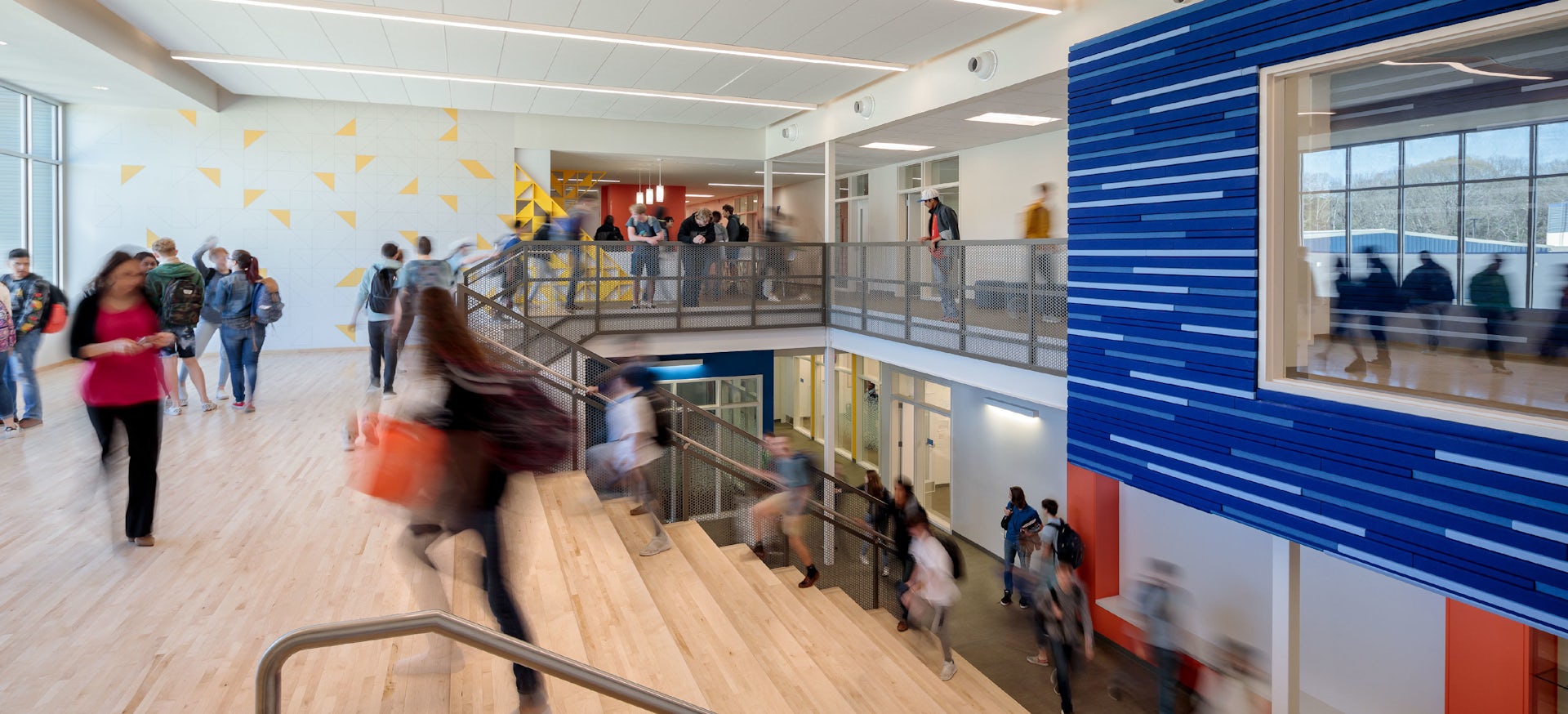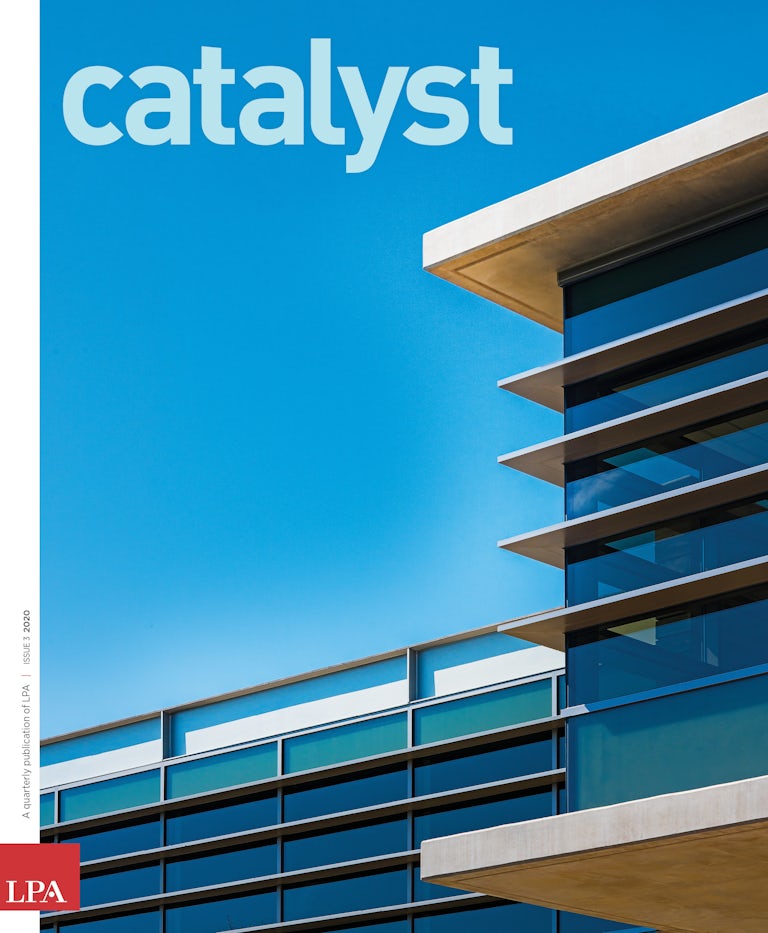As the Cumberland Academy expanded, administrators of the K-12 school in Tyler, Texas, wanted to create a campus to promote active learning, while addressing the social and cultural needs of the students.
“We wanted to develop the campus to focus on the whole student,” says LPA Design Director Kate Mraw. “The goal was to merge disciplines and establish the roots for a lifelong learning experience.”
After a series of workshops with educators and the community, the design was developed around the theme of “FACE”—Flexibility, Access, Collaboration and Engagement. The campus takes full advantage of the wooded site, creating a variety of outdoor social and learning environments. Interactive labs are co-located with classrooms, providing opportunities for hands-on learning. Athletic facilities were developed at the same time, representing the interests of students and the community; in addition, a 750-seat performing arts center is under construction.
A New “FACE” for a Texas School
A focus on “Flexibility, Access, Collaboration and Engagement” (FACE) drove the design of the new Cumberland Academy campus.

The heart of the new academic wing is a 3,600-square-foot makerspace that serves as the heart of the new campus. Students flow through the workshop zone, which is anchored by a large stool-height work island and readily available digital technology. Art labs on either side of the workshop are separated by glass and garage-style roll-up doors. Expansive glass windows and doors connect the spaces to the outdoor quad.
“The spaces within the labs are designed to accommodate an array of different uses and inspire engagement,” Mraw says. “Students are encouraged to take ownership of their spaces and find new ways to use the tools and work together.”

Our goal from the start was to support Cumberland Academy’s unique instructional culture and create a campus that will be part of the community for generations.

The school’s vision is to provide “a nurturing environment that inspires lifelong learning while using innovative technology to develop 21st century skills and fostering an appreciation of the arts.” The focus is on small class sizes and personalized attention “to enable students to achieve their maximum potential.”
The original campus, opened in 2015, was a 50,000-square-foot, two-story box constructed through a design-build model, with 20 classrooms, a cafeteria, a gymnasium and a traditional teachers’ lounge. Little attention was paid to the interests of faculty and the professional staff or to ways to take advantage of the wooded site.

Cumberland switched gears in 2016, when LPA was hired to tackle the campus’ future development. The process started with a reworking of the school’s master plan, including an outreach process with teachers, parents and local stakeholders to better understand the community’s needs.
“We brought an attitude of engagement,” says LPA Project Designer Jim Oppelt. “We wanted to learn more about what the school wanted and what made the school unique.” The process included an ongoing series of meetings where the community could review and comment on different options. “We wanted them to drive the design,” Oppelt says.

LPA’s work was split into three phases. The first phase saw the addition of the two-story academic wing, including space for fine arts and STEM work, as well as an athletic complex. In the second phase, workers installed artificial-turf sports fields, including a new track and field, a baseball diamond, practice facilities and what is described as the only Texas high school lacrosse field east of the Dallas/Fort Worth Metroplex. The third phase includes the performing arts center, with a full-fly theatrical rigging system, a dance studio, an art gallery and practice rooms for band, choir and orchestra.
In the new master plan, buildings were reoriented to reduce direct sunlight in rooms and maximize energy savings. Outside views are emphasized, recognizing the direct correlation to improved student achievement. A pedestrian spine connects the ample greenspace and a commons area where students congregate and eat lunch. The performing arts center takes on the role of campus hub.

We wanted to develop the campus to focus on the whole student. The goal was to merge disciplines and establish the roots for a lifelong learning experience.
The new campus addresses the needs and interests of the community on many levels, rethinking basic aspects of how the campus was operating. When the school opened, there was no outside space to speak of beyond the parking lot. Educators, teachers and students expressed a clear desire to boost the social experience on campus.
“We were able to work with the district to see what was possible,” Mraw says. “They didn’t realize they had the ability to deliver an environment like this on such a tight budget.”
The construction budget was capped at $142 a square foot, compared to then regional averages of closer to $225 to $250 a square foot. Design solutions focused on maximizing the limited resources. To help reduce costs, load-bearing wood, rather than steel, was used for an academic building; the athletic complex was built using pre-engineered metal.

A focus was placed on the functional, leaving funds to accentuate areas such as the performing arts center, which includes a tile wall and tile floor in the lobby. FACE drove the design, with spaces built for flexibility, in addition to access, collaboration and engagement. Makerspaces were designed to support multiple uses. For example, a wide, wooden stairway in one academic building can double as bleacher seating for a small, indoor amphitheater.
The spaces serve a variety of student experiences, from a student-run coffee shop and juice bar, to the amphitheater and smaller group rooms for focused learning.
“Our goal from the start,” Oppelt says, “was to support Cumberland Academy’s unique instructional culture and create a campus that will be part of the community for generations.”















